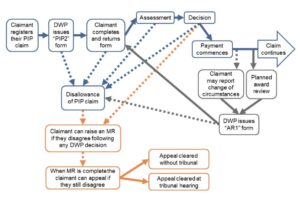Introduction
Background to the statistics
1.1 Personal Independence Payment is a benefit paid to people with an illness, disability, or mental health condition, to help with extra living costs.
1.2 The Department for Work and Pensions (DWP) asked the Office for Statistics Regulation (OSR) to assess its Personal Independence Payment statistics for England and Wales; demonstrating its commitment to produce statistics that meet the standards required of accredited official statistics (accredited official statistics are called National Statistics in the Statistics and Registration Service Act 2007) and the Code of Practice for Statistics.
1.3 DWP’s Personal Independence Payment (PIP) statistics for England and Wales provide information on:
- the customer journey through the PIP process,
- the volumes of claimants entitled to PIP at a point in time,
- registrations and clearances for different stages of the journey,
- outcomes at clearance and median clearance times,
- the customer journey, tracking initial decisions and award review outcomes following a PIP assessment.
One individual (claimant) could make separate PIP claims at different points in time, and these are counted separately. Data for these statistics are taken from DWP’s PIP and Disability Living Allowance (DLA) administrative computer systems.
1.4 The statistics are used by the UK Government to provide insights into the characteristics of people who are eligible for financial support and to monitor the performance of its welfare policy. The statistics are also used by other organisations such as charities who have a specific interest in the UK’s welfare system allowing them to carry out their own analyses and support their customers navigating through the system.
1.5 The statistics are published in a quarterly bulletin which includes several different charts, diagrams and tables to help visualise the data. More detailed data are published via DWP’s Stat-Xplore tool or presented in a number of tables in an accompanying spreadsheet, making the data available for download and reuse.
1.6 A helpful summary of the customer journey through the PIP claims journey is provided within both the statistical bulletin and background documentation:
Summary of Customer Journey
A typical customer journey is as follows:
- Claimant registers their claim to PIP.
- DWP issues the “How your disability affects you” (PIP2) form, for completion by the claimant.
- Claimant completes and returns PIP2 form – this can lead to: a) automatic referral to the Assessment Provider (AP); b) disallowance of the claim based on the information in the PIP2 form; or c) disallowance of the claim if the claimant fails to return the PIP2 form without being identified as having additional support needs.
- Under normal circumstances, the claimant may have their claim assessed based on the paper evidence already submitted, or may be called for a telephone, video, or face-to-face assessment conducted by the AP. The claimant may: a) attend and participate in their assessment; or b) fail to attend or participate in the assessment, which can lead to disallowance.
- DWP makes a decision based on the AP advice and any additional evidence received. The outcome may be: a) an award (including a monetary amount of the award for both Daily Living and Mobility components, the award type and, if appropriate, the period of time that should be allowed before a review of the award takes place); or b) a disallowance due to failing the assessment.
- Payment commences.
- When the claim is in payment, a claimant must report any changes of circumstance relating to the claim, and this may lead to a review of the award.
- Claims may undergo a planned award review when they reach the end of their review period (unless they received an ongoing award, where they will receive a light touch review after 10 years). Light touch reviews are in development and are due to begin in 2023.
- In the case of a reported change of circumstance or a planned award review, an “AR1” form is issued.
- If the claimant disagrees with a decision on their claim, including where an award has been given, they can ask for a Mandatory Reconsideration (MR).
- After the MR has been completed, if the claimant still disagrees with the decision they are able to lodge an appeal with His Majesty’s Courts and Tribunal Service (HMCTS).
- Some appeals are cleared without a tribunal hearing, where the following outcomes are possible: a) withdrawn by the customer, or struck out by the tribunal; or b) lapsed – where DWP change the decision in the customer’s favour.
- Some appeals are cleared at a tribunal hearing, where the following outcomes are possible: a) DWP decision upheld by the tribunal; or b) DWP decision overturned by the tribunal.
1.7 We have identified one requirement that DWP needs to address for these statistics to become accredited official statistics. Once the statistics team demonstrates that this requirement has been met, OSR will recommend that the UK Statistics Authority designate the statistics as accredited official statistics.
Back to top
